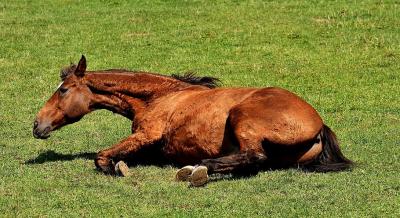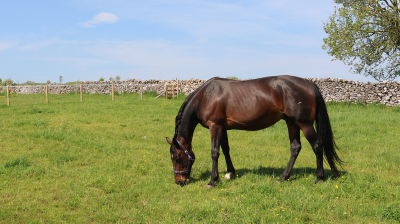
By vet Freya Wood
Colic is a common emergency we see and is a major concern to horse owners. It describes abdominal pain, usually related to the gastrointestinal system, but other conditions can present in similar ways, termed “false colic.”
Most colic episodes (64-72 per cent) are undiagnosed or spasmodic colics. Recent studies showed that around 24 per cent of colics either require hospitalisation for medical management or surgery. Surgical colics are not that common but require fast action to get the horse to surgery.
Colic is a complex condition, with over 80 possible gastrointestinal causes, so determining a specific cause can be challenging. Signs range from subtle (being quiet, grinding teeth and flank watching) to the more obvious signs that we associate with colic including pawing the ground, getting up and down, kicking the belly, rolling, sweating and muscle tremors.

There are a number of risk factors for colic. Some are to do with the horse itself and cannot be prevented, including age for certain types of colic and stereotypic behaviours such as crib-biting.
We can reduce our horses’ risk of colic with regular dental checks and having them on an appropriate worming programme.
Some types of colic are more common at particular times of year. Large colon impactions are often seen in autumn and winter as horses are stabled more, possibly eating straw bedding, and during cold weather horses may be less inclined to drink due to not liking very cold water, or periods where the water is frozen, so become dehydrated.
“False colic” can be discomfort associated with the liver or bladder or a high temperature causing signs that would be classically associated with colic. In pregnant mares, colic signs may be associated with foal movement, a twist in the uterus, or with foaling. Horses with equine grass sickness can also present with colic signs.
Most colic episodes can be managed on the yard with a combination of pain relief drugs (such as phenylbutazone or flunixin), buscopan and oral fluids. On some occasions more intensive medical management is required where it may be more practical for your horse to be admitted for repeated administration of fluids orally or via a drip, or for close monitoring.

Some colics require surgical intervention. This can be a difficult decision for owners. Factors such as existing health issues, including laminitis or arthritis, and whether the horse is insured will all play a part in decision making, along with how sick the horse is when first presented to the vet, particularly if the referral centre is some distance away. The earlier the horse is on the surgical table and the less sick it is at that point the better the prognosis.
Familiarity with what is normal for your horse (behaviour, heart rate, respiratory rate and temperature) can help identify problems early. If your horse is displaying colic signs your vet should be called straight away. While you are waiting for the vet to arrive, remove food from the stable. If safe for both you and your horse, you can walk the horse but not so much that the horse becomes exhausted. If the horse keeps trying to go down allow them to do so and ensure you remain safe.
Colic is frightening for many owners and it can happen with very little warning, so it is important to have a plan in place. Is your horse insured for colic? Do you have someone who can make decisions on your behalf if you are away? This can save a lot of time and stress in a fast-moving situation.